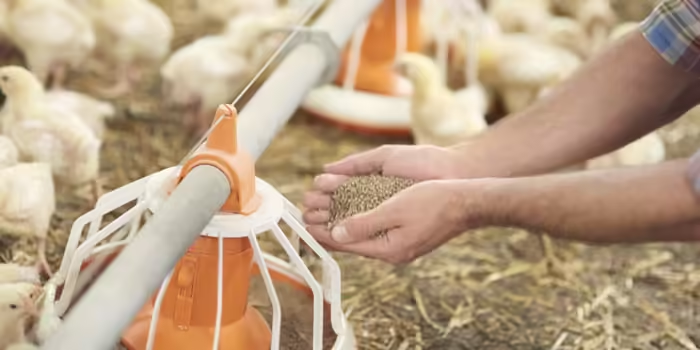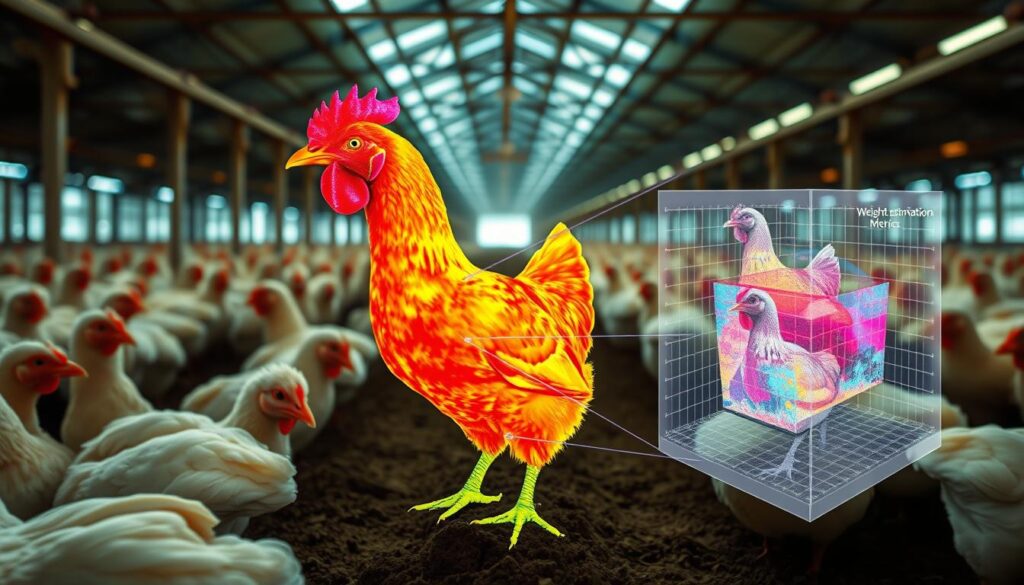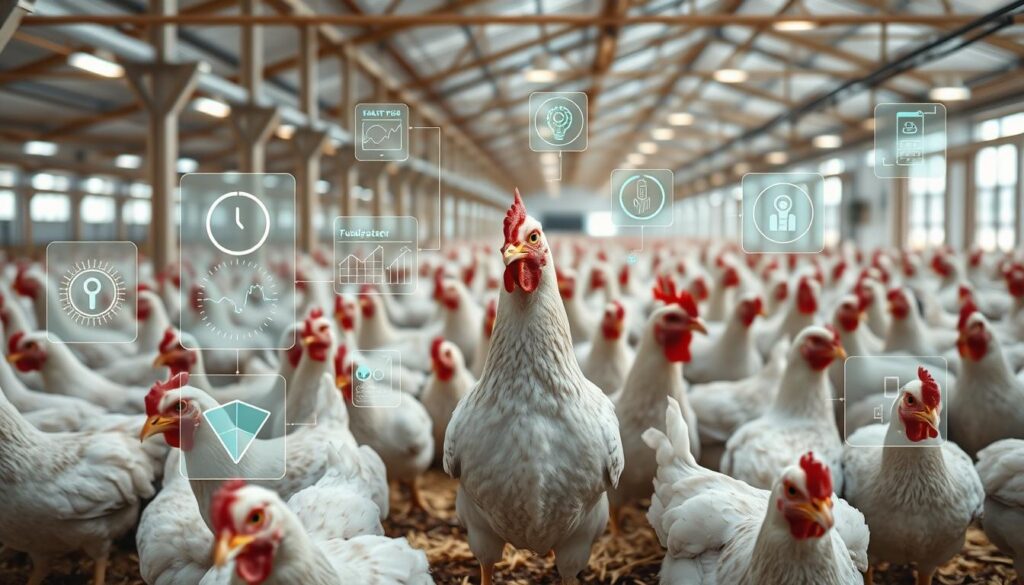
Monitoring broiler chicken weight is key to checking their growth and health. It helps track their daily growth, how well they convert feed to meat, and their overall health. But, the old way of weighing them by hand is slow, hard work, and stressful for the birds.
New ways to watch broiler chicken weight are becoming more important. They use digital scales and smart technologies like machine vision. These new tools help track growth better, letting farmers make smarter choices and improve their flocks.
Key Takeaways
- Broiler body weight monitoring is crucial for evaluating flock growth and performance.
- Automatic monitoring methods, such as digital scales and AI-based vision systems, are gaining traction to replace manual weighing.
- Innovative tools and technologies are enabling precision poultry production and data-driven decision making.
- Integrating weight data with climate control and feed optimization can further enhance broiler growth and productivity.
- Emerging technologies, like IoT sensors and precision livestock farming, are shaping the future of broiler monitoring and management.
Introduction to Broiler Chicken Growth Monitoring
Monitoring the growth of broiler chickens is key in modern poultry farming. It helps track the birds’ body weight and how evenly they grow. This information is vital for understanding their growth, health, and when they are ready for market.
Importance of Monitoring Broiler Body Weight
Monitoring the body weight of broilers is crucial for several reasons:
- It lets farmers see if the flock is growing as expected, helping them meet market weight goals.
- Checking how evenly the flock grows helps spot health or feeding issues that could affect performance.
- Knowing the exact body weight is essential for improving the feed-to-meat ratio, which boosts profits.
- Monitoring body weight in real-time helps farmers know the best time to sell the birds, maximizing profits.
Traditional Manual Monitoring Methods
For a long time, farmers used manual methods to check broiler body weight. They would pick and weigh a sample of the flock, usually 2% or 50 birds, whichever is more. But this method is slow, hard work, and can stress the birds.
In big broiler houses with 20,000 to 30,000 birds, manual weighing is almost impossible. This has led to the creation of new, better ways to monitor broiler growth. These new methods are faster and more accurate, helping farmers track their flock’s health and growth better.
Digital Scales for Automated Weight Tracking
New ways to track broiler chicken growth are changing poultry farming. Digital scales and automated weight tracking systems make it easy and accurate. They help farmers keep their flocks even and feed them better.
Big names like Fancom, Big Dutchman, and Veit make top electronic scales for poultry. These systems are set up by hanging them from the ceiling. This can be tough for farm workers. But, they are very precise, with over 90% accuracy.
Zhejiang University has a new body weighing system. It’s placed away from where chickens eat and drink. This setup reduces interference and has an average accuracy of 99.5% ±2.3%.
| Product | Accuracy | Installation |
|---|---|---|
| Fancom, Big Dutchman, Veit Electronic Scales | >90% | Hanging from ceiling |
| Zhejiang University Body Weighing System | 99.5% ±2.3% | Placed away from feeder and waterlines |
Using these digital scales for broiler weight monitoring and automated weight tracking systems helps farmers. They get valuable data to make their farms better and more profitable.
“The integration of smart farming technology, such as automated weight tracking systems, has transformed broiler management, enhancing flock uniformity, early health detection, and optimized feed efficiency.”
Vision-Based Body Weight Estimation
In recent years, new technologies like machine vision are being developed to estimate broiler body weight. However, feathers make it hard to get accurate readings with regular 2D cameras. Thermal imaging and 3D imaging might help improve the accuracy of vision-based body weight estimation methods.
2D Camera Challenges and Limitations
Traditionally, broiler weight is monitored by manually weighing a small sample of the flock. This method is slow and requires a lot of work, especially in large commercial houses. These houses can hold up to 30,000 birds.
Thermal and 3D Imaging Solutions
Researchers at the University of Georgia are working on a system to automatically monitor broiler weight. They use integrated 3D and thermal imaging methods. These technologies aim to overcome the issues with 2D cameras and provide more accurate vision-based broiler weight estimation.
Studies have shown that thermal imaging and 3D imaging can be very precise, with accuracy over 90%. For example, a platform developed by Zhejiang University has an average accuracy of 99.5% ±2.3%.
| Technology | Accuracy | Application |
|---|---|---|
| 2D Cameras | Limited by feathers | Vision-based broiler weight estimation |
| Thermal Imaging | Over 90% accuracy | Thermal imaging for broiler weight monitoring |
| 3D Imaging | Over 90% accuracy | 3D imaging for broiler weight monitoring |
| Integrated 3D and Thermal Imaging | 99.5% ± 2.3% accuracy | Integrated imaging solutions for broiler weight estimation |
Using thermal and 3D imaging solutions, poultry producers can better track their broiler flocks. This leads to better management and more informed decisions.

Poultry Health Monitoring: Detecting Bumblefoot
Poultry farmers work hard to keep their birds healthy. They focus on preventing bumblefoot, also known as pododermatitis or footpad dermatitis. This infection can harm the health and work of broiler chickens.
Bumblefoot causes swelling and damage to the feet. It can lead to serious problems if not treated. The infection can harm the foot’s tissues, bones, and tendons.
Studies show bumblefoot is common in different chicken homes. In cage-free (CF) housing systems, 38% of hens on dry litter and 92% on wet litter get footpad lesions. The problem often starts at 35 weeks of age, due to bad litter and equipment.
Researchers have found new ways to spot bumblefoot early. The YOLOv5m-BFD model can find bumblefoot with 93.7% accuracy. This technology helps keep chickens healthy and productive.
“Staphylococcus aureus (SA) (68%) and Enterococcus faecalis (14%) were the most common bacterial species found in egg-laying hens with bumblefoot, with Staphylococcus aureus infection decreasing production efficiency and leading to death rates of up to 15%.”
By using the latest in bumblefoot detection and poultry health monitoring, farmers can fight this problem. This helps keep their chickens healthy and working well.
Tools and Technologies for Monitoring Broiler Chicken Growth
The poultry industry is growing fast, thanks to a global demand for chicken meat. New tools and technologies are helping to monitor broiler chicken growth better. These tools improve how chickens are raised and help farmers make better decisions.
Digital Scales and Data Collection Systems: Digital scales linked to data systems track chicken weight in real time. This gives farmers up-to-date info on each bird’s weight. It helps them decide on feeding, health, and managing the flock.
Machine Vision and Imaging-Based Methods: AI and machine learning, along with 2D, 3D, and thermal imaging, are changing how we monitor chickens. These technologies can guess a chicken’s weight, watch its behavior, and spot health problems. All without touching the birds.
Using these tools in precision poultry farming is key. As the world’s population grows, so does the need for more chicken. These new methods help farmers raise chickens better, care for them more, and meet the demand for chicken.
“The poultry industry is expected to cater to a rising urban middle class, with an additional 3 billion people estimated to inhabit the Earth in the next 30 years.”
From digital scales to AI-powered imaging, new tech is changing the poultry industry. These tools help farmers make smart choices, raise chickens more efficiently, and care for them better. All while meeting the world’s growing need for chicken.
Precision Livestock Farming with IoT Sensors
The use of precision livestock farming and IoT sensors is changing how we monitor broiler growth. Farmers can now track and analyze data on broiler body weight in real-time. This helps them make better decisions about managing their flocks, improving feed use, and boosting production efficiency.
IoT sensors in precision livestock farming have become more popular. Research shows their value in monitoring dairy cattle and pigs. This highlights the wide range of uses for IoT sensors in farming.
Real-Time Data Collection and Analysis
Real-time data collection and analysis with IoT sensors lets farmers watch broiler growth closely. They can quickly adjust feeding and conditions to improve production. This makes farming more efficient and effective.
- Digital scales and vision-based technologies track broiler body weight accurately and in real-time.
- Advanced analytics and machine learning predict feed use, spot health issues, and optimize resources.
- Combining weight data with sensor info like temperature and air quality gives a full view of the broiler environment.
By using IoT sensors for broiler monitoring, farmers can work more precisely and efficiently. This leads to better profits and a more sustainable broiler industry.

“The livestock industry is becoming increasingly reliant on automated real-time monitoring, and precision livestock farming (PLF) is becoming a more widespread term alongside precision agriculture (PA), smart farming, and Industry 4.0.”
Automated Climate Control for Optimal Growth
Keeping the climate just right is key for broiler health and performance. Systems like the Munters Trio control temperature, ventilation, and air flow. They help reduce stress, improve feed use, and boost growth, leading to better broiler performance.
Modern tech has changed how we manage climate for broilers. It uses sensors and smart tech to adjust conditions in real time. This ensures broilers grow well in the best temperature, humidity, and air. It helps farmers grow healthier birds, use feed better, and make more money.
| Feature | Benefit |
|---|---|
| Automated temperature monitoring | Prevents heat stress, promotes healthy growth |
| Intelligent ventilation control | Maintains optimal air quality, supports respiratory health |
| Precision heating and cooling adjustments | Enhances feed conversion and weight gain |
Using these heating, cooling, and ventilation systems for poultry lets farmers create the best environment for their birds. This approach boosts efficiency and helps farmers get more from their investment.
Integrating Weight Data for Feed Conversion Optimization
Getting the best feed conversion rates and keeping weights even is key for a poultry farm’s success. By integrating weight data for feed conversion optimization, farmers can control air flow based on bird weight. This leads to improved feed efficiency and uniform growth. It also helps manage feed better.
Studies show how real-time weight monitoring for feed efficiency is crucial in broiler production. For example, Al-Nasrawi et al. (2013) used special functions to track broiler growth. Zuidhof et al. (2014) compared broiler growth and efficiency over years, showing progress in performance.
By leveraging broiler weight data for production management, farmers can make better decisions. They can tweak feed and air systems for better growth. This not only boosts feed conversion but also improves broiler health and welfare, leading to better productivity and profits.
| Metric | Traditional Methods | Computer Vision-Based Methods |
|---|---|---|
| Weight Estimation Accuracy | Lower accuracy due to reliance on manual measurements and regression models | Higher accuracy through advanced computer vision techniques and data-driven models, with R2 values up to 0.9942 |
| Scalability | Limited scalability due to labor-intensive manual weighing | Increased scalability through automated, non-invasive weight monitoring |
| Animal Welfare | Potential stress on broilers from manual handling and weighing | Improved animal welfare through non-contact weight monitoring |
By integrating weight data for feed conversion optimization, poultry farmers can reach their full potential. This leads to better feed efficiency, uniform growth, and higher profits. Using real-time weight monitoring and data-driven decisions is crucial for the future of precision farming.
Data-Driven Decision Making with Farm Management Software
In the fast-paced world of broiler farming, making decisions based on data is key to success. Amino by MTech Systems is a top farm management software. It helps broiler growers and integrators improve their operations and boost profits.
Amino offers real-time tracking of important metrics like weight gain and feed conversion. It also forecasts harvest weights. This data helps users make better decisions, leading to better flock outcomes and farm productivity.
Amino by MTech Systems for Broiler Farm Optimization
Amino has features tailored for broiler farmers. It connects with IoT sensors and collects data automatically. This makes farm management easier with its tools:
- It tracks broiler body weight and feed consumption for the best growth.
- It uses predictive analytics for better harvest weight planning.
- It calculates key performance indicators like feed conversion ratio and production efficiency factor.
- It helps manage health and disease to keep poultry well.
- It also manages finances for better budgeting and profit.
Broiler farmers can make better decisions with Amino’s data insights. This leads to better flock performance, lower mortality rates, and higher farm productivity.
“Amino by MTech Systems has been a game-changer for our broiler operation. The real-time data and automated analytics have allowed us to optimize every aspect of our farm, from feed management to disease prevention. It’s truly a must-have tool for any modern broiler producer.”
As precision livestock farming grows, so does the need for data-driven decisions. Farm management software like Amino is crucial for broiler success. By using these technologies, broiler growers can achieve greater efficiency and profit.
Emerging Technologies in Broiler Monitoring
The poultry industry is using emerging technologies to better monitor broiler growth and manage farms. They’re adopting digital scales, imaging-based weight estimation, and precision livestock farming with IoT sensors. These innovative solutions aim to boost efficiency, animal care, and profits.
The global chicken market is expected to hit $429.11 billion by 2028, growing at 5.45% annually. Digital phenotyping is key in Precision Livestock Farming. It offers real-time monitoring and management of animals, improving efficiency and sustainability.
IoT devices in poultry houses collect data on temperature, humidity, and air quality. AI tools analyze birds’ activity for health insights. But, using these digital phenotyping technologies in broiler farming needs big investment, skills, and infrastructure.
Managing and securing data is vital for digital phenotyping technologies. The success of these technologies relies on careful use, strong data management, and security. This ensures better production, animal care, and environmental impact.
Advancements in Broiler Weight Monitoring
Traditionally, broiler weight is monitored by manually weighing a small part of the flock. But, with large flocks, this method is hard to do in real-time.
New systems for monitoring broiler weight are coming to market. They use electronic scales from brands like Fancom, Big Dutchman, and Veit. These systems have over 90% precision. A new system from Zhejiang University has 99.5% accuracy and doesn’t interfere with feeding or watering.
Researchers at the University of Georgia are working on a system that uses 3D and thermal imaging for automatic weight monitoring. This is a big step forward in future trends in broiler farming.
The SMART Broiler program got $1.625 million in Phase II funding. Another project at Georgia Tech University is developing an audio-monitoring tool. These projects aim to help the 9 billion birds in the U.S. each year. They will be tested in two barns: Tyson Foods in Arkansas and Master Good in Hungary.
“The success of digital phenotyping in the broiler industry depends on responsible application of technologies, robust data management, and security measures to optimize production, elevate animal welfare, and reduce environmental impact.”
Monitoring broiler chicken growth is key for better poultry farming, animal care, and farm success. The industry is moving fast to use digital tools like automated weight tracking and IoT sensors. These tools help farmers make smart choices, improve feed use, and boost their farm’s performance and profits.
This article has shown how far broiler monitoring tech has come. It uses machine vision and AI for weight checks and tracking feed intake. These advances help farmers manage their flocks better and care for their animals more effectively.
With more people wanting chicken, using these advanced tools is vital. They help farmers produce chicken in a way that’s good for animals and the planet. By using data and precision farming, farmers can do better for their animals and their businesses.